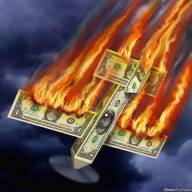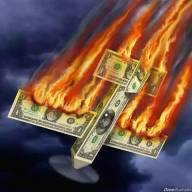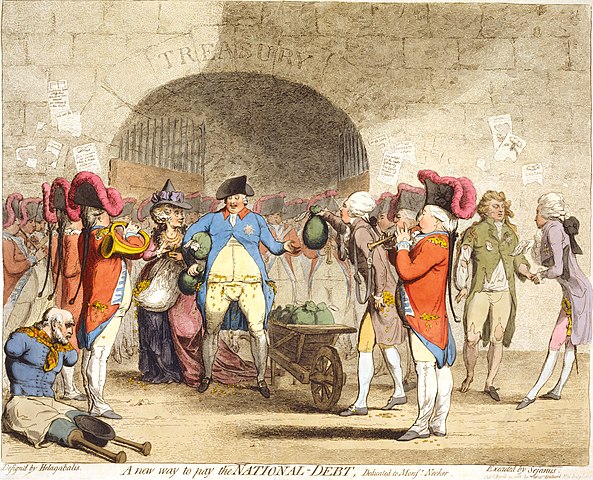Even if almost no one wants to admit it, our “system” is obsolete, and for this reason it is now morphing into a “closed system” – totalitarian in nature.
It is equally clear that the few who continue to benefit materially from the capitalist system (the 0.1%) are willing to do whatever it takes to prolong its obsolete existence. At its root, contemporary capitalism works in a simple way: debt is issued from one door and purchased from another through the issuance of new debt in a depressive loop from which most of the destructive phenomena of our time originate.
The facilitators of the “debt-chasing-debt” mechanism are a class of profiteering technocrats whose main psychological trait is psychopathy. They are so devoted to the mechanism that they have become its extensions – like automatons, they work tirelessly for the mechanism, without any remorse for the devastation of human life it dispenses. The psychopathic dimension (uninhibited, manipulative, and criminally antisocial) is not, however, an exclusive prerogative of the transnational financial clique, but extends both to the political-institutional caste (from heads of government to local administrators) and the so-called intelligentsia (experts, journalists, scholars, philosophers, artists, etc.). In other words, the institutional mediation of reality is now entirely mediated by the mechanism itself. Whoever enters the system must accept its rules while also, ipso facto, assuming its psychopathological traits. Thus, blind capitalist objectivity (the drive for profit-making) becomes indistinguishable from the subjects representing it.
Because of their personality disorder, the technocrats in the control room tend to overestimate their ability to enforce a closed system that might conceal the decline of capitalist socialization. First, the tragic pandemic farce, and now the cold wind of permanent warfare, are putting the average citizen’s unconditional trust in their representative institutions to the test. If it was relatively easy to silence doubt and dissent with “humanitarian lockdowns” and emergency rule – which allowed a most opportunistic political class to briefly regain some clout – the complicity in the Gaza genocide coupled with the neo-McCarthyistic construction of the “democratic front against the Russian monster”, with related arms race, are beginning to undermine the old certainties of the silent majority.
In the new totalitarian normal, reality does not quite make it to the newsfeeds or television screens. What we get instead is the hyperreal as theorized by Jean Baudrillard, which is neither real nor fiction, but the narrative container that has replaced both. Thus, the brutal ethnic cleansing of Gaza continues at full throttle along with heart-bleeding humanitarian concerns for civilians, telegenic appeals against all forms of extremism, and cynical warnings of rampant antisemitism. At the same time, we are reminded 24/7 that the Russians (who else?) are preparing for nuclear cyberattack from space and the invasion of Europe. Without even realising it, the conspiracy theory ghostbusters turn into the very thing they love to hate. The resulting maelstrom of infotainment induces a state of collective hypnosis which proves to be more effective than traditional censorship, since it eliminates ex ante the request for a real referent, in all its radical ambiguity.
The hyper-mediation of the world aims to become the only available world. The events narrated by corporate media are no longer thought of as something other than their narration, since, in the hyperreal reversal, it is the narration itself that thinks the subject. Our saturated info-space is in the form of an infinitely malleable self-referential spectacle that a priori sterilizes all critical thought. The official debate on Gaza or Ukraine, for example, is continuously reframed into a debate on the debate itself, strictly demarcated by morally preformatted binary codes (democracy/terrorism, etc.). This tendency to liquidate the referent must be understood in its etymological sense as a tendency to “make it liquid”. It established itself, historically, as a consequence of a process of economic virtualization based on the replacement of the profitability of wage labour (real valorisation) with the simulated profitability of speculative capital.
We live in a world where the stock markets of Japan and the United Kingdom reach record highs as their economies slip into recession, while the United States manages to stay afloat courtesy of a monstrous deficit guaranteed by monetary and military hegemony. Regardless of the crash or drastic correction in the making, the ongoing financial market party (with very few invitees) is inextricably connected with the euphoria of war. Why? First, military production for “long-term security commitments” is now an essential support for increasingly sagging real growth as measured in GDP. For example, 64% of the $60.7 billion allocated to Ukraine in the latest aid package will be absorbed by the US military industry. The source here is not Putin’s TASS but the Wall Street Journal, which also admits that since the beginning of the Ukrainian conflict, US industrial production in the defence sector has increased by 17.5%.
But, above all, techno-military-industrial excitement continues to function as tailwind for a hyperinflated financial sector now in thrall to AI mania. The current S&P 500 bubble is the result of the hysterical overvaluation of a handful of tech corporations, the so-called Magnificent Seven (Alphabet, Amazon, Apple, Meta, Microsoft, Nvidia and Tesla, which today are actually down to the Magnificent Two: Nvidia and Meta). The strong imbalance closely resembles the dot.com tech bubble of the late 1990s, when the internet excitement led to the overvaluation of Microsoft, Cisco, Amazon, eBay, Qualcomm etc. While these companies managed to save their own skins, many start-ups were wiped out by the bursting of the bubble. Ergo, a sensational market moved by the lever of Artificial Intelligence would do better to prepare itself for an equally sensational fall.
Let’s keep in mind that financial risk today is immensely higher than twenty-five years ago. Over the last two decades, the system has made itself hostage to the rather elementary ruse called “creation of liquidity out of thin air” (and related scapegoats), whose purpose is to refinance the mass of outstanding debt which supports state deficits as well as speculative bubbles populated by heaps of zombie companies. A stock market collapse of around 80%, like that of the dot.com at the end of 2000, would now be equivalent to a barrage of atomic explosions – metaphorically and literally. This is because the warmongering psychopathy is, ultimately, an extension of financial psychopathy: the real outcome of out-of-control speculative risk. This explains why a technocrat superstar like Ursula von der Leyen, president of the European Commission, calls for the production of ‘weapons like Covid vaccines’ – inadvertently spilling the beans about the real purpose of both.
The armament industry is the Cerberus-like guardian of financialized capitalism, which in its traditional version – the fantastic world of full employment, hedonistic mass consumption, endless growth, and democratic progress – has been dead and buried for quite some time. Hence the undeclared objective of the US and vassal states: to maintain military hegemony both as backbone of monetary hegemony (dollar as global reserve) and to protect an already virtually unsustainable mass of toxic debt. This is why Estonian Prime Minister, Kaja Kallas, recommends the same monetary strategy implemented during Covid for the EU: the issuance of 100 billion in Eurobonds (750 billion were mobilized as Coronabonds in 2020) in order to relaunch the EU’s military industry whilst awaiting the new barbarian invasions. Borrowing to deal with Putin and other “apocalyptic emergencies” duly packaged by the media is the last-ditch economic model of crisis capitalism. The internal limit (collapse of the mode of production) is denied through its external projection, embodied by providential enemies who are thirsty for democratic blood. “War bond” as fiscal bulwark: this is how the liberal, progressive, and morally superior West faces its own implosion.
The arms race has started almost everywhere. In Great Britain, General Patrick Sanders, head of the British Army, proposes a massive recruitment of citizens to send to the (obviously, Russian) front, while the new Defence Minister, Grant Schapps, cannot even be bothered to conceal the economic opportunism of the call to arms:
‘[…] the era of the peace dividend is over. In five years’ time we could be looking at multiple theatres involving Russia, China, Iran and North Korea. […] Firstly, we must make our industry more resilient to empower us to re-arm, re-supply and innovate far faster than our opponents. There’s a huge opportunity here for British industry. The UK has long been a by-word for pioneering technologies. We gave the world radar, the jet-engine and the world wide web. We’ve not lost that spark of creativity. On the contrary, today the UK is one of only three $1 trillion tech economies. But just imagine what we could do if we managed to better harness that latent inspiration, ingenuity and invention for the Defence of our nation?’
As they did during Covid, EU technocrats read from the same script. Like children in kindergarten, they sing in unison the same warmongering nursery rhyme. If Germany, France, Poland and the Baltic countries are now bracing for decades of war against Russia, even Austria (a non-NATO country whose economy continues to be highly dependent on affordable Russian gas) and Sweden (traditionally neutral) have jumped on the bandwagon.
In short, the act of brandishing the Russian scarecrow is gaining momentum and the war drums are rolling. Above all, this means that we are entering an era of growing military indebtedness for the (supposed) monopoly on violence in multiple theatres of war which, precisely because financially motivated, must never disappear from sight. As Julian Assange put it in 2011, referring to Afghanistan, ‘the goal is an endless war, not a successful war’. This scenario comes with socioeconomic and cultural decadence, repression of dissent, and coercive manipulation of impoverished plebs. But it would be delusional to believe that the narrative of the West’s “noble military commitment” is merely the latest episode of a Netflix show we can afford to watch from the safe distance of our sofas, perhaps washing our consciences with some generic pacifist slogans. Because the more the model of financial capitalism falters, the more those who continue to profit from it will not hesitate to sacrifice under “democratic bombs” not only the “wretched of the earth” of which Franz Fanon wrote (populations, like the Palestinians, who have long been abandoned to conditions of subhuman misery and abuse), but also the placid dwellers of the “affluent world”, who are as highly considered by the elites as a herd of grazing cattle with a smartphone glued to their nose.
The now permanent call to arms (against Virus, Putin, Hamas, Houthis, Iran, China, and all the baddies to come) functions as a desperate as well as criminal cover for a failing economic logic at the mercy of its financial degeneration, and the incessant administrations of credit from Central Bank computer screens. The emergency drama must be stoked without interruptions, or the balloon that carries the “civilization of profit” will burst. Differently put, the profitability of the financial casino, which has decoupled from and replaced the profitability of mass labour, is increasingly dependent on barbarism.
As the monetary methadone guaranteed by the psycho-pandemic is running out, liquidity issues are once again coming to a head. The central bankers’ monetary policy of higher interest rates is at risk of flopping if, as it seems, the balance of the Federal Reserve’s reverse repo facility (which by draining liquidity acts as a primary indicator of bank reserves) continues to nosedive, while the BTFP (Bank Term Funding Program, the emergency loan program created by the US central bank in March 2023 to deal with the crisis triggered by the bankruptcy of Silicon Valley Bank) comes to an end in mid-March. In a repeat of September 2019, the ominously labelled “March madness” could heighten the risk of a bloodbath in the debt markets. Here it is important to note that loans from traditional banks to the shadow banking system (the poorly regulated financial sphere populated by pension funds, insurance companies, hedge funds, asset managers, etc.) has recently exceeded 1 trillion dollars. The recipients of these loans – highly leveraged non-bank financial companies – package and invest them as debt to increasingly risky subjects.
Such increase in leverage, already at the heart of the 2008 crisis, is an obvious indicator of growing systemic volatility. According to data from the Financial Stability Board (US Supervisory Authority), to date shadow banking assets amount to 218 trillion dollars, approximately 50% of global financial assets. These are mostly highly leveraged securitisations and repurchase agreements (repos), which constitute the essence of today’s financial system: debt structured into more debt; a forward flight of debt-based speculation without real underlying value. The fragility of this mechanism is intrinsic, since the insolvency of a single player would cause the entire pyramid to collapse, subsequently triggering large-scale economic contagion. For this reason, the financial sector (“a house of cards built on a pool of petrol”) is perpetually thirsty for liquidity. It is therefore fairly easy to predict what comes next: in a setting already dominated by a QT policy (reduction of the central bank balance sheet) that is essentially bogus – as it is offset by fixed-term emergency programmes like BTFT – the Fed (and associates) will soon need the lever of new major emergencies to justify cutting interest rates to inject freshly minted liquidity into the system.
It is interesting to observe how Western political and economic institutions, even when harshly criticized, are depicted by the media as if in a painting from the early Middle Ages: without context. They exist eo ipso, in a self-referential metaphysical aura that immunizes them to the relationship with their real environs. Individually, of course, politicians and technocrats are regularly reprimanded and ridiculed. Their governing institutions, however, which in principle are responsible for carrying out tasks of public interest, remain untouchable, for they supposedly embody the highest point in the scale of “best possible worlds”. Yet, especially in light of today’s events, it should be easy to see how the quasi-sacred character of liberal-democratic governance hides its total dependence on the movements of financial capital. The moral pillars on which liberal power is built are, more obviously than ever, an extension of the amoral drive of capitalist profitability.
The Western middle classes are prisoners to their past, convinced that post-war liberal-democratic capitalism, as a model of social organization, is not only fundamentally just, but also eternal and unquestionable. This optical illusion, which up to now has led to an almost unconditional trust in our institutions (even when harshly criticised), is understandable: the Western middle classes have for years been the object of big capital’s most loving attentions, in the context of a profitable social contract organised around mass wage labour and growing consumption habits. Capital, in other words, has shaped and at the same time exploited a work society modelled on the “ideal standard” of the worker-consumer gratified by the dream of upward social mobility. But these were the days of the baby boomers, who still delude themselves that they are ontologically relevant, while in truth they were always opportunistically engineered into a post-war economic boom that, incidentally, resulted from the “creative destruction” of two world wars. And the point is that such a “world” lasted, in the capitalist centre, for about thirty years, which are like the flutter of a hummingbird’s wings when compared to the centuries-old history of a mode of production that, in Marx’s words, comes into the world ‘dripping from head to foot, from every pore, with blood and dirt.’[i]
The fog of war, in which we are now once again lost, hides from view the real object of contention: not the enemy to be fought but our toxic dependence on the mother of all modern illusions – the illusion, that is, that capital spontaneously generates a civilizing social bond. The civilization I’m referring to is the same one that today justifies the shameless extermination of the Palestinians. Such extermination is all the more atrocious the more it conforms to the racist matrix of a “development model” of society that, as a rule, imposes its values by crushing those who do not conform to them – including millions of the destitute and the oppressed who testify, with their painful diversity, to the very failure of capitalist socialization. Our noble institutions now increasingly act as psychotic hitmen in the pay of big capital. Is it still possible for us to trust them?
Notes:
[i] Karl Marx, Capital: A Critique of Political Economy, Volume 1, trans. Ben Fawkes (Penguin Books: Harmondsworth, 1976), p. 926.
Intro Image: Cartoon depicts a slovenly-attired King George III and Queen Charlotte standing before the Treasury with moneybags under their arms and with a surfeit of gold guineas overflowing their pockets and bursting from the fly of the King's breeches. William Pitt, his pockets similarly overflowing, hands the king another moneybag from a pile in a wheelbarrow. The Prince of Wales (heir to the throne) stands to the right, destitute in torn rags and missing a shoe; he is being handed a check saying "Accept £200000 from your friend Orleans". A quad-amputee sits on the ground to the left with an empty begging hat between the stubs of his prostheses-fitted legs. Posters on the wall read "Last Dying Speech of Fifty-Four Malefactors executed for robbing of a Hen-Roost" and "Just published for the benefit of Posterity: The Dying Groans of Liberty".
Author
Fabio Vighi is Professor of Critical Theory and Italian at Cardiff University, UK. His recent work includes Critical Theory and the Crisis of Contemporary Capitalism (Bloomsbury 2015, with Heiko Feldner) and Crisi di valore: Lacan, Marx e il crepuscolo della società del lavoro (Mimesis 2018).



















